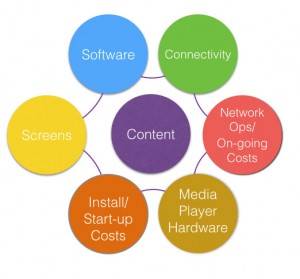
The digital signage industry provides business solutions to many different vertical industries from retail to transportation to healthcare to financial services. In general, these solutions can be broken down into external (public facing) or internal (employee facing). Most of the solutions are comprised of a core set of similar hardware and software components with differences in content based on the audience and purpose of the network.
This article tackles the cost components associated with building out a digital signage solution for an application that spans multiple vertical industries – the Internal Communications Digital Signage Network. Before we get into the components, I do want to remind the reader of some of the purposes of digital signage in Internal Communications:
- Maintain or increase positive employee engagement
- Motivate a workforce (performance management dashboards)
- Educate and inform employees on company events, policies and procedures
- Entertain employees and visitors in lobbies
So what are the cost components of such a network?
I break down the components into seven categories:
- Media Player Hardware
- Software
- Screens
- Content
- Connectivity
- Installation/start-up costs
- Network Operations/ongoing management
Media Player Hardware
Digital Signage media players range from special purpose Linux and Windows based appliances to small form factor PCs and rack mounted servers. Environmental installation constraints, content requirements (think ultra high def video or interactivity) and budget often dictate the type of hardware utilized. In the past several years many networks have adopted low cost (and low power), ultra small form factor players that can be mounted behind the displays. This sometimes allows for reduced costs over PC towers or servers with stacked video cards and expensive video splitters and cabling. Media Players come in a variety of OS and software configurations. Recently Chromeboxes and other low cost Linux based hardware (HDMI sticks in some cases) have gained popularity in the industry.
Most of the media player providers in the industry sell pre-configured media players that are plug and play with their own Content Management Systems. However, you can purchase stripped down and “bare bones” systems. You may save a little money by rolling your own media player, but you’ll likely spend more time and money loading, configuring and testing someone else’s software on the boxes once you choose a content management system.
Digital Signage media players from a variety of suppliers start around $300 (Google Chromeboxes start at $229) and go up to well over $1,000 depending on CPU, memory, storage and specific OS and software configurations. A short list of some of the providers is listed below (in no particular order):
- AOpen
- Brightsign
- Broadsign
- CAYIN
- ComQi
- Nexcom
- Scala
- Real Digital Media
- Haivision/Coolsign
- Mediasignage
- RMG
- Digitalsignage.com
Media Player Software (includes access to Content Management Systems)
Digital Signage Media Player software ranges from free (or freemium) to ~$25 per month depending on the purchase volume. Predictably, the per node pricing has dropped over the years and veteran software providers in the industry have increasingly moved to provide additional bundled services (content, support, training, etc.) in order to stay afloat. All the way back in 2009, Dave Haynes, author of the popular 16:9 blog, reported that industry prices for SaaS were settling around “$25 – $30 a month in low volumes”. Recent conversations I’ve had with friends in the industry confirm things haven’t changed much since then.
On average, budget $25 per player per month for software and CMS. This may or may not include support from some vendors.
Screen Hardware
LED screens, monitors, TVs, displays – call them what you want but they are the most visible part of your digital signage network. Prices range from $300 for consumer/prosumer versions up to tens of thousands for large format ultra high-definition and outdoor displays. Size and features affect price, of course. Manufacturers like LG, Samsung, Planar, Sharp, NEC, ELO and many others have a variety of models with different features.
Rather than go into all the details on how to select displays here, I’ll leave it at this – displays are a commodity. Find a manufacturer or reseller that provides a solid product, good warranty support and the features you need and stick with them. For commercial/corporate applications, don’t head to Best Buy or Tiger Direct and pick up the cheapest refurbished unit unless you’re ok with replacing it in a year when it fails and you don’t have a warranty to fall back on.
I also won’t go into the All in One (AIO) offering space here since I broke out media player hardware in the section above. Just know that there are models with integrated CPUs that retail a little higher than models without a CPU.
Assume $400 – 500 per display for a 42″ with a good 2 to 3 year warranty.
Content
“Content is king,” as declared back in 1996 by Bill Gates. No doubt many others have echoed this phrase over the years – and for good reason. Without content on your digital signage network, all you’ve really got is a bunch of monitors and computers. The digital signage industry highway is littered with the remains of failed network pilots and deployments because too little attention was paid to content. I’ve personally seen or heard of dozens of projects fail after a few months because of the content (or lack thereof). Content is hard to get right. It takes research, surveys, planning, more research, production, curation, testing, and more research to get it right. It’s hard to know what motivates people and how to keep their attention in today’s frenetic business world. Emails, mobile devices, meetings, project deadlines all compete for an employee’s attention.
But content is where you get your bang for the buck and your ROI from digital signage – so don’t skimp on content quality or the content strategy.
What should you budget for content? It’s tough to generalize content costs – even for Internal Communications – because the sources of content vary just like the purposes of different networks vary. But let’s make some assumptions and consider the following the variable components (and sources) of content for most networks:
- Content Planning/Strategy – Successful networks factor in time and money before deployment to sit down with a content consultant or in-house expert and and map out a sustainable publishing plan. To keep your employees engaged with your displays, you need a variety of informative and entertaining content. Agencies might charge anywhere from $3,000 – 10,000 for a discovery meeting (or meetings) plus a detailed content plan that helps you achieve your goals. If you do it in house, you should still budget the time and headcount to understand your sunk costs that go into the network.
On average, budget ~$6,500 annually.
- Content Production – Successful networks also budget headcount or outsourced expenses for regular customized content production. So whether you rely on an existing employee or use a free lancer or agency, let’s assume $65 – 90 per hour (fully loaded) for graphic design with motion graphics and digital signage system expertise. Assume you need 16 – 20 hours of production per month for your network. On average, budget $1,395 per month. If this seems high, budget it anyways and you can treat your team to pizza when you come in under budget.
- Syndicated Content – The Digital Signage industry spawned several syndicated content sources over the past few years. Companies like ScreenFeed and AccuWeather provide a variety of curated content templates for everything from entertainment news to sports, financial news and stocks, trivia and of course weather. ScreenFeed’s website does a great job of providing easy to understand per player/per month pricing and is a good resource for budgetary content planning. Again depending on what your network content objectives are, you could spend anywhere from $15 per display per month up to $100. At a minimum, assume you want some weather and basic news/sports feeds to keep things interesting.On average, budget $30 per display per month.
- In house data sources – Many internal digital signage networks are set up for the sole purpose of making key performance indicators visible to employees. It’s long been known that giving employees visual indicators of progress against goals can be a motivating factor. Companies use digital signage to setup real time dashboards to track everything from individual and group sales against goals to production line information and project milestones. Data for much of these metrics come from a variety of systems – both in-house and third party. Taking advantage of APIs, many digital signage software platforms offer integration with popular business intelligence, CRM and workforce management platforms. Since many of these systems already exist within a corporation before the digital signage network’s introduction, the costs can sometimes be considered sunk or at least outside the scope of the digital signage. However, there may be some one-time costs for custom programming to integrate the systems.
On average, budget $2,500 for integration. This is a one time cost.
Connectivity
Media file storage is generally provided as part of the Content Management System. However, media file transfers between a digital signage network up to the Content Management System server(s) and then back down to networked media players often traverse the public Internet so bandwidth usage costs should not be ignored.
Bandwidth utilization is a function of several variables:
- Playlist/loop lengths
- Media file sizes (function of bitrates)
- Feed data (weather, sports, news, etc.)
- Other player/server data communications (player to server housekeeping – this should really be negligible)
- Playlist/loop update frequency
Once you’ve determined your content matrix and playlist needs, you can calculate values for the variables above and come up with the necessary bandwidth required to get files up to your network server and down to your media players. If you’re running everything behind the corporate firewall, it’s possible that server to player communication and file transfers may occur over your corporate WAN instead of hitting the Internet. However, your weather and other syndicated feed data will come from outside (unless you’re manually creating your news and weather feeds in house – painful!).
I tend to ignore connectivity costs because I think of Internet access and bandwidth as sunk costs within a corporation. Most (but not all) Internal Communications Digital Signage is pretty light on the quantity of high bitrate video and instead makes more use of data feeds and motion graphic content which can be less bandwidth intensive than video.
Note: I may come back and edit this section with some example data.
Installation/Start-up Costs
Depending on the desired screen locations, installation costs can vary wildly. In my experience from managing installations in both retail and corporate locations, you could be looking at as little as $125 per screen to as much or over $1,000 per screen. For corporations with in-house maintenance and IT resources that handle installation, some of the cost of hanging screens and mounts may be minimized. But in general, you need to consider several factors:
- Is any construction labor required? For example, to flush-mount or recess screens into walls.
- Is electrical needed or already present at the screen locations?
- Are the media players being mounted behind the screens? If so, you don’t have to worry about A/V cabling labor costs.
On average, budget $350 per screen.
Network Operations/Ongoing Costs
For ongoing costs, you need to consider the care and feeding of your network. We’ve already discussed monthly content costs but you also have to take into consideration the labor costs to keep the network running smoothly. Even with software automation, people are still needed to oversee content curation and publishing from time to time and for troubleshooting and break-fix.
The types and sources of content you use on your network can affect your Network Ops costs. If you rely on a lot of manually produced content, you’ll need someone to load up the content, review it, schedule it for playback. If you use mostly data feeds and subscriptions, you’ll spend less time and money on the publishing aspects of Network Ops.
Most of the Content Management Systems for digital signage have some level of device monitoring built into their player software components. So depending on the platform you use, network monitoring may be more or less reactive instead of proactive. In other words, some systems will send you an alert when a screen is offline or down. Some won’t and you have to come up with ways to monitor – including third party monitoring software.
To estimate labor costs for Network Operations, I take an employee’s fully loaded salary and make a guesstimate as to how much time they’ll be working on digital signage. For some large networks, it’s common to have a dedicated employee that owns the Network Operations Management function. For smaller deployments, several hours a week of someone’s time may be enough.
For argument sake, let’s say a $80,000 employee will spend 1 hours a day managing content and verifying connectivity on a mid sized (10 – 100 screens) network. This assumes some good software, a solid network and a well oiled content production process. Let’s add 20% for overhead on the salary and then divide by 2000 (50 weeks * 40 hours). We get $48 per hour. Multiply that by 20 and you’ve got your monthly estimate of $960. You can divide this back out by the number of media players and come up with a pretty reasonable per player cost. Obviously, using this logic the cost scales pretty well but experience tells me that once networks get above a few hundred players, the management time goes up as well.
You can make educated guesses on screen and media player failures based on published mean time between failure (MTBF) data from manufacturers. In my experience using at least 2% for hardware failure on the first year of a deployment is a safe and conservative number. For issues caused by human error (someone dropping a screen while hanging it, for example), rates may be higher during installation phases. Players going offline due to environment factors should hopefully be minimal in corporate settings but you’re reliant on the network connections on your media players.
Internal Communication Digital Signage Network Sizes
There are several questions that are useful in determining how many screens to deploy (and what sizes are needed) to be effective.
- How many employees are grouped in areas that allow them viewing access to screens?
- What are the foot traffic patterns of your floor/building?
- Where are the common areas and meeting rooms and how many do you have?
- Are you going to send content to displays in the meeting rooms? Are you going to install door displays that feature room scheduling information outside conference rooms?
Let’s assume you have roughly 5 common areas per 100 employees. Common areas include kitchens/small cafes, departmental cube farms/work areas, large meeting rooms, lobbies and large hallways – anything not a bathroom, office or elevator/stairwell.
For definitional purposes:
- Small Business = under 100 employees
- Assume ~5 screens in common areas
- Medium Business = 100 – 999 employees
- Enterprise = 1000 employees and up
Summary
The assumptions and advice given in the sections above are based on my experience operating digital signage networks and working for digital signage software and service providers. No matter what the software and hardware vendors say, there is no such thing as a silver bullet or one size fits all solution for digital signage networks. Take time to carefully plan all aspects of your network, especially content and the ongoing operations and your network will provide you with a valuable return on your investment.




